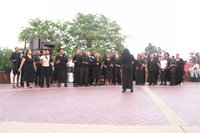Dave Eggers, author of the best selling memoir "Heartbreaking Work of Staggering Genius," will be in town for Notre Dame's literary festival. He is scheduled to speak on Thursday, February 8th, 8 pm in Room 101, DeBartolo Hall. The event is free and open to the public.
While his memoir was overhyped for me, his other literary and social ventures have earned him my respect and admiration. (He founded McSweeney's. Check out the link in my sidebar.) His newest book, "What is the What," is fiction that tells the all-too-true story of one of Sudan's Lost Boys. (See review below.)
This is well worth risking your extremities on a cold February night!
Other authors at Notre Dame this week:
Poet
Lolita Hernandez, 10:30 am Monday in room 210, McKenna Hall and 8 pm Monday in LaFortune Student Center ballroom
Palestinian poet and playwright
Nathalie Handal, 7pm Monday in LaFortune ballroom
Poet
Hal Sirowitz, 8 pm Tuesday in the Oak Room, South Dining Hall
Essayist and humorist
David Rakoff, 8 pm Wednesday in LaFortune ballroom
Freelance writer
Anne Elizabeth Moore, 6:30 pm Thursday in room 129, DeBartolo Hall
Mining the power of fiction Eggers' novel
tells story of a 'Lost Boy' of Sudan
by Bob Thompson
WASHINGTON POST
Here are a few things we can say for sure about Dave Eggers' latest book:
It's not a satire of political correctness in the English department of an elite liberal arts college. No publisher is betting that it will be "the next 'Da Vinci Code.' " Judith Regan had nothing to do with it.
Oh, and it's a safe bet that Eggers didn't consult any marketing types about the title.
He called it "What Is the What."
Which means ...
Well, maybe we should save that for later. Because right now the writer best known for his arrestingly titled memoir "A Heartbreaking Work of Staggering Genius" is sitting in a newspaper conference room with Valentino Achak Deng, the Sudanese "Lost Boy" whose life story he's undertaken to tell. And he's talking about one thing readers of "What Is the What" can't say for sure: How much is fact and how much is fiction.
Why the line-blurring? The explanation goes like this: Introduced to Deng in early 2003 and deeply engaged by his story, Eggers set out to write a conventional biography. But he kept getting stuck.
"I didn't know how to do it," he says. "I didn't want my own voice in there."
Despairing, he was ready to give the whole thing up. Then it occurred to him that "all the books that we remember about war and about the biggest events of the 20th century are novels." Think of "The Naked and the Dead," "Catch-22" and "all Hemingway's stuff."
More important, think of the ways fictionalizing Deng's story could solve narrative problems. By labeling the book a novel, Eggers says, he freed himself to re-create conversations, streamline complex relationships, add relevant detail and manipulate time and space in helpful ways -- all while maintaining the essential truthfulness of the storytelling.
There was only one hitch.
"I was so afraid to ask Valentino," Eggers says.
Author and subject grin at the memory. Eggers, in a white shirt and a sport coat that's seen better days, is the shorter and more intense-looking of the two. Deng, in a black shirt and jeans, is tall -- as the Dinka people tend to be -- with a warm, gap-toothed smile.
They call each other "Dave" and "Val," but Eggers, who's 36, has had the luxury of keeping the same name all his life. Deng, who's a decade or so younger, has been known as "Achak" (the name his parents gave him), "Valentino" (a baptismal name), "Dominic" (from a teacher in a refugee camp), "Gone Far" (a nickname alluding to his long trek out of war-wracked Sudan) and, most poetically, "Sleeper" -- bestowed by a girl who found him lying in the road one day, half-blind and longing for death.
Here's how Eggers, in Deng's voice, describes the moment:
"I conjured my mother as best I could. I pictured her in yellow, yellow like an evening sun, walking down the path. ... When she came up to me I told her I was too tired to continue, that I would suffer again, and would watch others suffer. ... Then I washed her from my mind. It seemed to me that to die I needed to clear my mind of all thoughts, all visions, and concentrate on passing on."
You look like my dead brother, the girl said. She lifted him up and got him walking again.
Lost Boys is a name attached to thousands of young refugees from the civil war in southern Sudan, which broke out in the mid-1980s and continued until peace was finally negotiated in 2005. "It is not a nickname appreciated by many in our ranks," as Deng the book character puts it, "but it is apt enough."
These days, Deng and the roughly 4,000 other Lost Boys who were resettled in the United States often find themselves confused with victims of more recent savagery in Darfur. But while the atrocities committed by government-backed militiamen have been similar -- "the difference is just the name they're using to describe the militia," he says -- Darfur is in western Sudan. Marial Bai, the hometown from which Deng was driven in fear of his life, is farther south.
His journey began in the mid-'80s, when, as a 6-year-old, he was still young enough "to be weak and melt into his mother's arms." Trouble had been brewing between the African peoples of southern Sudan and the Arab-dominated government in the north. But the boy knew nothing of the complex history behind the conflict.
"I couldn't understand," he says. "There was me in my town, my father was doing well -- why do we want to go to war? No reason."
Reason or no, war came.
Arab militiamen on horseback overran Marial Bai. Deng saw his hometown burned, his friends and neighbors killed or abducted. Not knowing his parents' fate, he fell in with a group of similarly displaced boys. An adult leader set them walking toward Ethiopia, where they were told they would find a haven, despite having no idea what "an Ethiopia" was.
The horrors of that walk cannot be easily summarized.
In "What Is the What," there are scenes of famished boys ripping the flesh off a dead elephant; of a boy dragging a stick as he walked, "making a line in the dirt so he would know his way home"; of land mines, ravening lions and exhausted, starving "sleepers" who gave up and died along the way.
Once across the border, a refugee camp became a recruiting ground. Rebel leaders told the boys, many destined to become child soldiers, that they were "the seeds of a new Sudan." Driven out, eventually, by the Ethiopians, the boys escaped across the Gilo River in a hail of gunfire -- except for those who got shot or were intercepted by crocodiles.
Reaching safety in Kenya, they found themselves trapped in a bleak refugee camp called Kakuma for -- in Deng's case -- 10 years.
How he finally got to the United States is an epic in itself. Being scheduled to fly on Sept. 11, 2001, did not help. Plunked down in Atlanta, he got to know the founder of a nonprofit called the Lost Boys Foundation. Her name was Mary Williams, and she came to view him as an especially articulate spokesman for his Lost Boy peers.
One day, he says, Williams asked about his long-term goals. "I would like to be able to document my story," he told her, "in a written form that generations will have access to."
OK, she said, she'd find somebody to help.
Mary Williams didn't know Dave Eggers, but she'd happened to pick up his memoir once when she needed airplane reading.
"The title was just hilarious," she says.
"A Heartbreaking Work of Staggering Genius" is the saga of how, when Eggers was in college, his parents contrived to die of cancer within five weeks of each other, leaving Dave and his sister to raise their 7-year-old brother. The memoir's out-of-nowhere success left Eggers with enough cash to fund a variety of literary and philanthropic projects, among them the tiny independent publishing house McSweeney's and a literary magazine, the Believer, as well as a writing workshop and tutoring center in San Francisco.
Williams read up on Eggers and was impressed. He's "kind of like a Lost Boy himself," she says. So she wrote and asked if he'd like to get involved.
The idea was a long shot. How many name-brand authors would drop everything to tell a Lost Boy's story? But Eggers, as it happened, was already intrigued by the long march of the Sudanese refugees.
So he flew to Atlanta to check things out.
He bonded with Deng right away and began taping interviews. Later, they wangled their way onto a plane delivering aid to Sudan -- "we sat in the cargo hold with the grain and the bicycles and stuff," Eggers says -- to do a little firsthand research. In all, they spent thousands of hours together. It took him that long, he says, "to be able to see through Valentino's eyes."
As for the fiction decision: When Eggers raised the idea, he feared that Deng would angrily reject any reimagining of his real story. But "right away he was like 'What? Do whatever! Do anything you want!' "
"Dave is an artist," Deng says. "I'm not only about myself in the book." The idea was to tell the most accessible story possible about the devastation so many had endured.
Back and forth they go, deferring to each other, holding forth on their shared narrative.
They talk about how the original idea was to tell just the African part of Deng's life, until Eggers realized that his subject's struggle to adapt to the United States -- and the numerous disasters he has experienced here -- had to be part of the story.
They talk about their plan to use profits from the book to fund Deng's education, aid other Sudanese refugees, help rebuild Marial Bai and promote peace and justice in Darfur.
What does the future hold for Deng? Will he stay in his adopted homeland, where he is attending Allegheny College?
"I would like to bring up my kids here," he says. "But then I also, at the same time, want to make differences in Sudan."
"What Is the What" was published by McSweeney's, which allowed Eggers the total freedom he likes but means there's no marketing machine behind the book. Nonetheless, it's picked up some terrific reviews and made it to No. 25 on the New York Times' extended best-seller list this week.
As for that mysterious title: It's taken from a creation story Deng remembers hearing as a child.
God, it seems, made the first Dinka man tall and strong and the first Dinka woman beautiful. When he was done, he offered his creations a gift. "You can either have these cattle," he told them, "or you can have the What."
"What is the What?" they asked. But God refused to answer. The choice was a test. The Dinka could go for the cattle, which they knew would allow them to live well, or they could take a chance on the unknown. They chose the cattle, which, as the story's moral had it, proved the wise thing to do.
Except ...
The stable, solid universe in which that decision made sense is gone. And in the Lost Boy world of strife and stress and endless change that has replaced it, embracing the unknown -- as Valentino Achak Deng can tell us better than anyone -- looks like the only choice there is.






